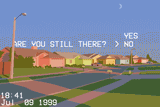>>7652633 (OP)It's too broad a question. Pixels are really a medium; furthermore, the approach to the medium is different depending on whether the intended output is an old CRT television set/computer monitor (or simulation thereof) or a modern HD screen. The fundamentals are still rooted in drawing and painting. The unique challenges of pixel art mostly manifest in small or low-resolution images and have to do with suggesting shapes, angles and lines within a very constrained space of possibilities wherein one or two pixels make a big difference in how something might be interpreted by the viewer. Some pixel artists avoid whenever possible making lines at angles that require irregular numbers of pixels at each step (i.e. 2, 2, 3, 2, etc.) because these lines are uglier than those that increment regularly (2, 2, 2, etc.), although this can be limiting. To learn other "tricks" (such as antialiasing and sub-pixel animation), it's best to study old games that do these things well, and apply what you learn to your own, original works. There's really no great secret. Again, it's mostly drawing and painting to begin with, and if you can do those things well, then pixel art doesn't have a very steep learning curve.


